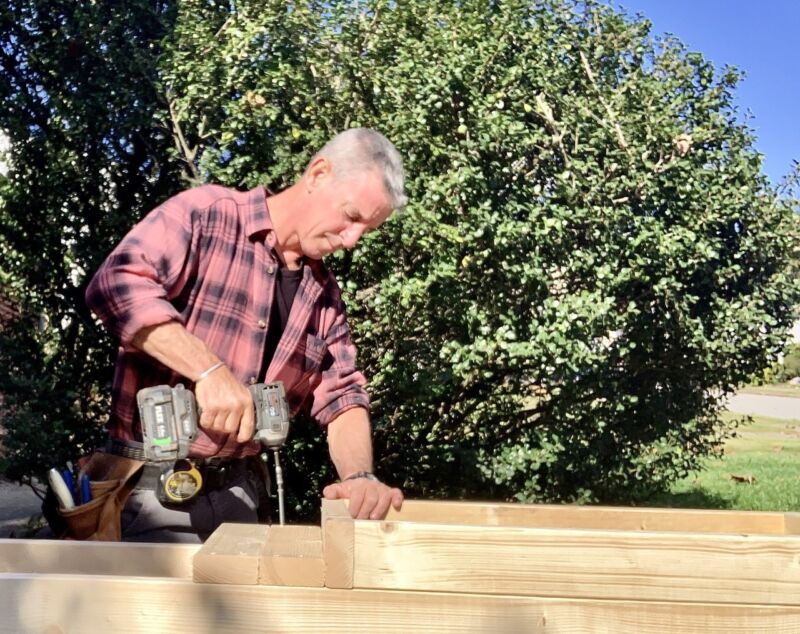
The new FLEX impact driver is savage; find out why in Mark’s tool review.
My tool review on Flex impact drivers is contrary to posts I’ve seen on social media by people who have never had these tools near their hands.
Table of contents
What should you know about the Flex Tools impact driver?
You may have seen a Flex impact driver at Lowe’s, as well as in my scintillating ‘How to Demolish a Shed’ video. Refined in detail, optimized for output, smartly and creatively designed, the tools from Flex are also ground-pounders.
Take their cordless impact driver: I don’t know how they got so much tool in this tool, but they did.
How’s the battery and power?
There’s a couple of inputs I should share first before getting into Mark’s Tool Review of the Flex impact driver. Mainly, I drive a lot of screws. And I drive a lot of meaty #10 x 3-inch screws in the decks I build and other framing, so I need a heavy weight that can run.
While I’ve really enjoyed most of the impact drivers I’ve owned, I could heat them up to just this side of cherry red screwing off a deck surface. I actually shook the overmolds off of one I own. The more typical smaller batteries—Flex is hurling Arnold-esque 5-amp-hour 24-volt caged demons—can’t hold a candle to the rip curl of this platform for bulk screwing.
I don’t know how they got so much tool in this tool, but they did.
What’s with the half-sizer battery?
The kit I got also had a half-sizer—no joke in its own right at 2.5 amp-hours. Even though I’m often driving screws by the bucket-full, I like this because I also need to engage framing in a bay window installation or odd connections in a basement remodel or pre-drilling cabinet face frames in maple. I was about to say the unit is a bit much for installing kitchen cabinets, but it isn’t. I have a 12-volt “installer” impact and it’s so slow compared to the Flex, I use the Flex impact driver.
It’s common sense that using a nice, light battery in the 2.5-ah range would make life easier. And it is practical in interior work like the kitchen I’m installing. Balancing the bigger 5.0-amp-hour dealio inside a base cabinet is doable, but a lot of work. All that is to say, during this tool review, it took me a while to figure out what needs Flex was meeting with a light battery and a monster battery.
Now I get it.
I love how balanced the Flex impact driver is for both batteries. Reaction torque is near zero on both platforms. And the 2.5 is in the game. But if you want an impact that gets $%^&*() angry at it, the 5.0 is your posse.
Battery exchange is easy both from the tool and the charger. Maybe it’s a little sticky.



How’s the bit holder and exchange?
I love and challenge the ¼-inch hex bit exchange. This is truly a new development in this field of tools. Rather than pull the collar back to release or insert a bit, you depress the “trigger” above the trigger and that opens the bit holder. It’s fabulous. And now, it’s become muscle memory.
But there is another bit holder feature I also hold in high regard and it’s the one where you can just slot the bit in without pulling the collar. Combined, these two features would rock the universe.
Got a pile of screws to drive? Holes to drill? Old house framing to make new house framing? 5.0 is corded power.
What’s the final verdict on this tool?
To summarize—as my now adult daughter said as a little girl—this cow will hunt.
Flex impact driver tool review rating: Full chooch.
What do you think about this tool? Got any questions I didn’t address in the tool review? Share your comments below or send us a note.


I recently purchased an impact driver for my DIY projects, and it has been a game changer. The amount of time and effort it saves me is incredible! I wish I had invested in one sooner.
What are some key features to look for when selecting an impact driver for DIY projects, and how do they differ from those needed for professional use?
It depends what you’re doing what features in an impact driver matter most, but generally speaking, for pro use you’re looking for a durable tool that feels good and balanced when you pick it up. I like one with a little heft to it to dampen the impact energy generated by running a tool all day, say building a deck.
I also look at the amp-hours in the batteries that come with the tool–for two reasons. One, amp-hours are like the size of a gas tank in a car. They don’t make the tool run any better*, but they enable it to run longer. Volts measures the energy–the gas–in the tank. I want higher amp-hours batteries for the tools I run, for the most part. I also want a higher amp-hour battery because they often align with larger batteries and stout tool bodies that absorb that impact energy better than lighter duty tools.
* I honestly think that higher amp-hour batteries do make the tool run better. I have no science to back this up, but in “fat-pack” versus “slim-pack” tools–especially this Flex–are way better for the way I use the tool.
This all comes at a premium price and is not necessary for DIY.
For occasional use, slim pack, less-stout tools do an amazing amount of work. Their fit and finish isn’t ideal, but for making repairs and getting stuff done around the house, they’re incredible tools.
And, as I say for every tool purchase, buy the best tool in your budget because chances are the more you use it, the more you’ll use it and you’ll appreciate that you invested in something you can grow into instead of grow out of.
I recently purchased an impact driver for my DIY projects, and it has been a game changer. The amount of time and effort it saves me is incredible! I wish I had invested in one sooner.
What are some key features to look for when selecting an impact driver for DIY projects, and how do they differ from those needed for professional use?